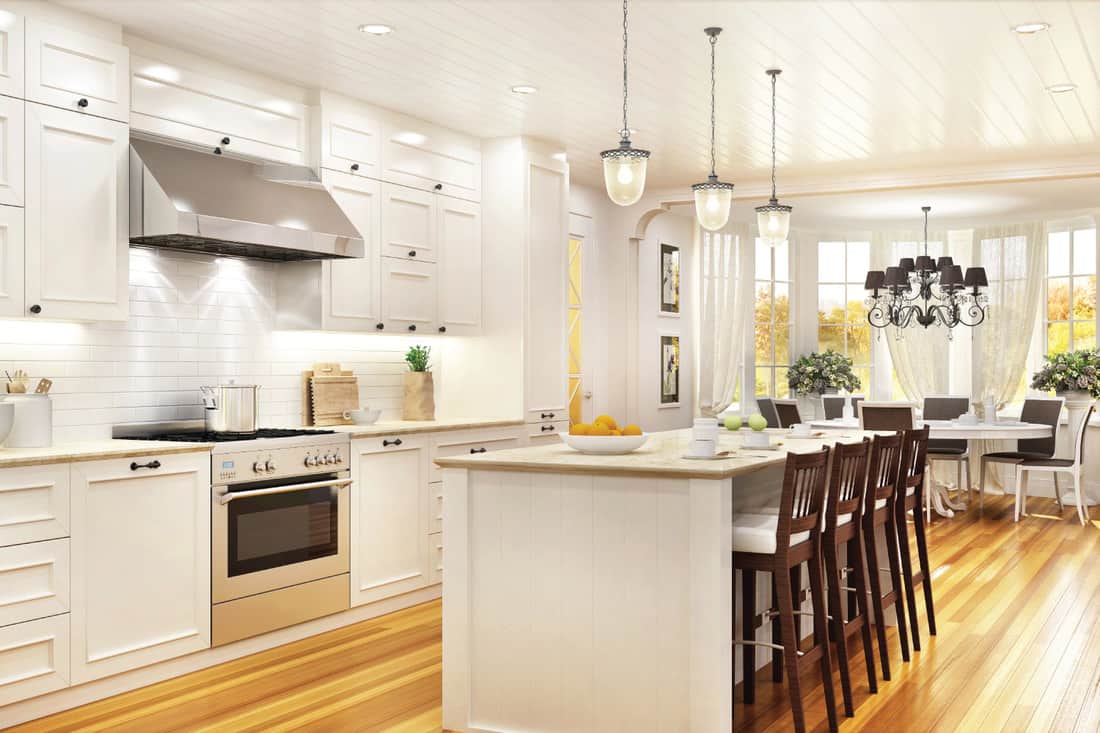Remodeling a kitchen can be challenging. There are so many elements - floors, cabinets, countertops, accessories, backsplash, walls, and more. Then you have to pick the right colors. And even the right finish! It's a headache, but we're here to help. White cabinets are currently the most popular color. If you'll be sticking by classic white, we've checked with designers for the best advice. What color floor goes with white cabinets?
Some great floors to show off white cabinets are:
- Light-wood
- Dark-wood
- Gray
- Black
- Brown
- White
- Marble
But why stop with floors? Keep reading for advice on picking out more fantastic matches - countertops, backsplash, and more. This article covers what should match - and what shouldn't. Finally, we'll give you some pointers on colors. Not using enough colors makes the room boring. But too many colors create a room that is busy and intense. So what's the right number? Read on to find out!

Floor Color With White Cabinets
Light Wood
We sometimes add affiliate links and content that was curated and created by our team with the help of advanced ai tools to help showcase the best design styles.

Dark Wood

Gray

Black

Brown

White

Marble

Okay, sure, technically, marble is a pattern. But it goes perfectly with white cabinets, so how could we leave it out? The marbling automatically coordinates the white cabinets and floor together. This helps unify and blend the elements. But, the additional colors in the marble add some excitement and keep it interesting.
You can even pick a shade from the marble for a matching backsplash. This would be the perfect, well-organized decor for an elegant and gorgeous kitchen.
Should Kitchen Floor Match Countertops?
When designing your kitchen, you don't have to make an exact match between the flooring and the countertops. It's generally a better idea not to match. Too much similarity can be dull. However, you want a cohesive, unified look that ties all the room together's large features.
For this reason, you may want to pick a flooring that complements the counter in a similar finish. For example, if the counters are shiny, don't choose a matte floor. As for the color, it doesn't have to be an exact match. Remember, too much of one color is boring! Instead, pick a shade that highlights or complements the color of the countertop.
It can also help to coordinate the floor and the backsplash for a great look. For example, pick a shade that's reflected in the countertop. Accent it in the flooring and a similar backsplash. Now you have a thematic and well-designed room that any decorator will approve of.
If you want to pick a backsplash and then find the perfect flooring, check out this guide: What Color Backsplash Goes With White Cabinets in the Kitchen.
And if you need some help selecting a countertop, check out this guide: What Color Countertops Go With White Cabinets?
How Do I Match My Floor To My Cabinets?
It's better to pick a floor that contrasts the cabinets rather than matches. Since the cabinets and floor make up the bottom half of the room, matching too closely will make both features blend rather than allow each to stand out. You don't want the feel of the room to be flat and lifeless.
But, if you're using wood cabinets and wood flooring, try to maintain the same tone. Otherwise, two unrelated wood tones may be competing with each other. This effect tends to be jarring and disruptive.
How Many Colors Is Too Many?
With all of these different items in the kitchen, how much should match? How many colors can you add to a room before it's too much? A good guideline for home decor is the 60-30-10 rule.
In this method, you use three colors. The first color should be relatively muted or neutral, and it will make up about 60% of a room's design. Bold or bright colors are typically too saturating to be used that heavily.
The second and third colors can be more intense, with the last color being the most dramatic. These are 30% and 10% of the room, respectively. If you stick to three colors in these amounts, you'll always create a well-balanced room.
Of course, this is just a guideline. You can do more, but decorators agree - one room should never have more than five colors. It's just too chaotic to have that many colors all fighting against each other. Pick a few and let them harmonize.
What Color Floor Is Easiest To Clean?
As a general rule, lighter hardwoods show less dirt and dust than darker colors. Scratches and imperfections in the wood are also less noticeable in lighter shades. Similarly, lighter colors in vinyl or tile tend to make dirt less noticeable - except white.
An all-white floor, or conversely, a very dark floor, will appear dirty very quickly. For this reason, colors in the middle (light but not white) are typically the easiest to keep clean. Gray, in particular, is a good choice for an easy-to-clean floor. Using patterns and floors with a lot of variation will also help reduce the appearance of dirt. You can read more about the advantages of dark versus light flooring here.
Do White Kitchen Cabinets Go Out Of Style?

In Closing

White kitchen cabinets are a classic look that works in any decor. For the perfect flooring, consider wood floors, gray, white, black, brown, or marble. A helpful hint is to pick a countertop first and then find a floor that complements or highlights a color from the countertop. Similarly, also be sure to coordinate the countertop and floor finish. Both surfaces should be shiny or matte but not mixed.
For an especially well-planned design, coordinate the color of the floor with the backsplash. If you follow all of these steps, you'll create a harmonious and aesthetically pleasing room that any decorator would love.

